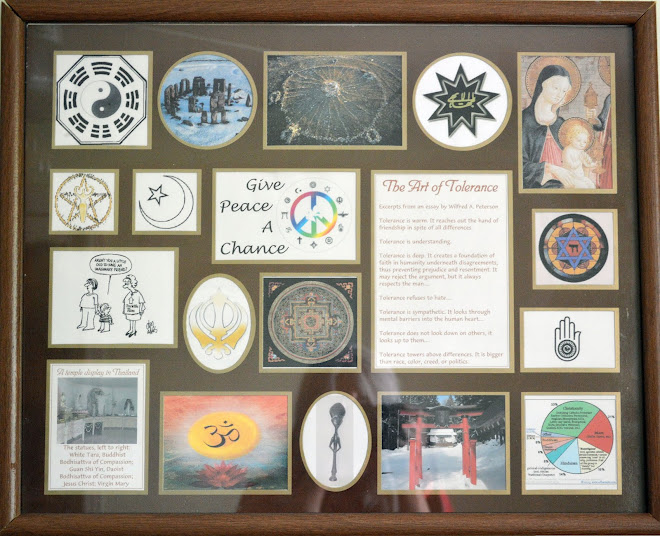The Story of She Who Watches, a Wishram legend.
She said, "I'm Sagalala, She Who Watches. I like to watch over my people to see that they have enough food. I like to watch over my people to see that they have enough fire wood. I like to watch my people to see that they have good shelter. I like to watch my people to see that they live in peace."

This particular article was a bit of a challenge. There are plenty of Earth Gods and Goddesses, but personifications for Earth are a little harder to come by. However, I did manage to find quite a few after a morning's search.
It is interesting to note that all of the traditions who have personified the Earth have polytheistic or animistic leanings. Their reverence for the Earth leads them to respect and care for it.
Anglo-Saxon
http://www.englishheathenism.homestead.com/introduction.htmlThe Angles are said to be a tribe that were protected by forests and rivers, and a tribe that along with six others took part in the worship of an Earth Mother goddess called Nerthus.
British/Celtic
http://www.peacexpeace.org/learn/motherearth.aspCailleach is the Celtic earth goddess who ruled the imaginations of ancient Ireland's and Scotland's Druids. Her name came to mean "Old Wife," but literally means "The Veiled One," referring to her mysterious and transformative power.
http://www.newtara.org/newtara_glossary.aspÉriu: 'Noble/High One'. A daughter of the Dagda, this goddess is Sovereignty, and a personification of Ireland itself. It is from her name that Éire, 'Ireland' is derived.
Daoist (Chinese Folk Religion)
http://www.angelfire.com/tv2/nj3/Goddess.htmlHu Tu-" Empress Earth" in Chinese mythology, this Goddess embodies and personifies the earth and in the spring and its fertility. She teaches us how to live abundantly while maintaining a reciprocity with nature. She also teaches us how to see and incorporate nature's lessons.
Egyptian
[One of the few who considered the land male and the sky female] …Geb, god of the earth, and his wife and sister, Nut, goddess of the sky. Geb and Nut, in turn, were the parents of Isis, Osiris, Nephthys, and Set.

Greek
http://en.wikipedia.org/wiki/Mother_NatureDemeter, goddess of the harvest, whose name originally meant 'earth mother,'
In this Greek myth [Demeter and Persephone], Demeter, the earth mother, has the power to deny humankind fruits of the harvest. A mother so powerful and so vengeful is an ambivalent figure in myth and history. The metaphor of mother nature continues to permeate the imagination of painters and writers, whose perceptions shape their audiences' images of, and beliefs about, mother, nature and women in general.
http://en.wikipedia.org/wiki/GaiaGaia or Gaea derives from the Greek words Ge (γη) = Earth (Pelasgian), and *aia = grandmother (PIE).

Hindu
http://en.wikipedia.org/wiki/Mother_goddessIn the Hindu context, the worship of the Mother entity can be traced back to early Vedic culture, and perhaps even before. The Rigveda calls the divine female power Mahimata (R.V. 1.164.33), a term which literally means Mother Earth.
http://en.wikipedia.org/wiki/PrithviPrithvi is the Hindu earth and mother goddess. According to one tradition, she is the personification of the Earth, and to another its Mother, being prithivi tattwa, the essence of the element earth.
Lithuanian
http://www.britannica.com/eb/topic-176089/Earth-motherIn both Latvian and Lithuanian religions the earth is personified and called Earth Mother (Latvian Zemes mate, Lithuanian Zemyna).
Native American
http://en.wikipedia.org/wiki/Mother_NatureAlgonquin legend says that "[b]eneath the clouds [lives] the Earth-Mother from whom is derived the Water of Life, who at her bosom feeds plants, animals and men" (Larousse 428). She is known as Nakomis, the Grandmother.
http://www.godchecker.com/pantheon/native_american-mythology.php?deity=CHEHOOITChehooit - started life as a barren formless planet, but it wasn't long before a huge helpful frog, along with certain other Godly Animals, tunneled and burrowed within her and gave rise to hills and valleys, fields and rivers.
Roman
http://inanna.virtualave.net/roman.htmlTerra Mater/Tellus, ancient Roman earth goddess. Probably of great antiquity, she was concerned with the productivity of the earth and was later identified with the mother-goddess Cybele. Her temple on the Esquiline Hill dated from about 268 BC. Though she had no special priest, she was honoured in the Fordicidia and Sementivae festivals, both of which centred on fertility and good crops.
Scandinavian
http://en.wikipedia.org/wiki/JordIn Norse mythology, Jörð (or Jarð in Old East Norse; Earth, sometimes Anglicized Jord or Jorth) is a goddess and the personification of the Earth. She is identified with Fjörgyn and Hlôdyn (Bellinger 1997:235).
Jörð is the everyday word for earth in Old Norse and so are its descendants in the modern Scandinavian languages (Icelandic: jörð, Faroese: jørð, Danish/Swedish/Norwegian: jord). It's a cognate to English earth. [The J is often pronounced as a long-e sound, equivalent to a Y; as such, "jard" is the equivalent of "yard" as in the earth/plot of land/yard around your house; backyard, front yard, etc.]
Shinto
http://www.unification.net/ws/theme033.htmAll you under the heaven! Regard heaven as your father, earth as your mother, and all things as your brothers and sisters.
Oracle of the Kami of AtsutaSlavic Myth and Religion
http://www.winterscapes.com/slavic.htmMokosh is an earth goddess. She rules over fertility and midwifery. She is commonly called Mati-Syra-Zemlya, or "Moist Mother Earth." … Mokosh is dark, like good, black soil. She is portrayed with uplifted hands, flanked by two horsemen. … One prayer to Mokosh involves going to the fields at dawn in August with jars filled with hemp oil. Turn East and say: "Moist Mother Earth, subdue every evil and unclean being so that he may not cast a spell on us nor do us any harm." Turn West and say: "Moist Mother Earth, engulf the unclean power in your boiling pits, in your burning fires." Turn South and say: "Moist Mother Earth, calm the winds coming from the south and all bad weather. Calm the moving sands and whirlwinds." Turn North and say: "Moist Mother Earth, calm the north winds and the clouds, subdue the snowstorms and the cold." Oil is poured out after each invocation, and finally, the jar is thrown to the ground.
Sumerian
http://www.geocities.com/spenta_mainyu_2/sumer2.htm… goddess Ki was the personification of earth.
http://timeemits.com/HoH_Articles/Sumerian_6_Sign_Zodiac_and_Mayan_Calendar_360.htmBabylonians replaced the earth-mother Sumerian “Ki” with “Ea.”








